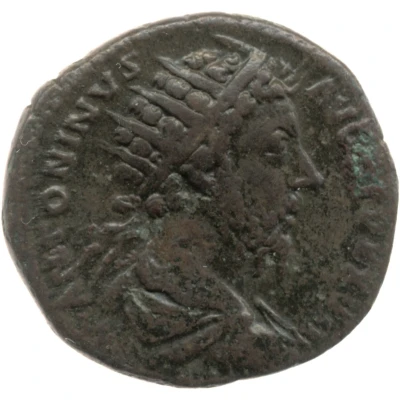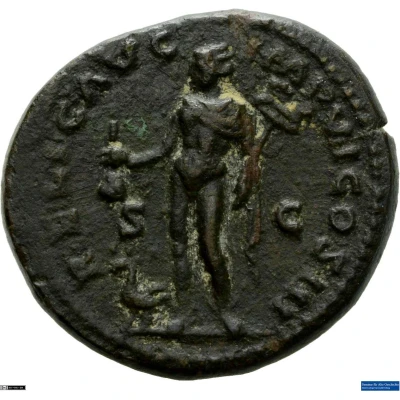


© Trustees of the British Museum
Dupondius - Marcus Aurelius RELIG AVG IMP VI COS III S C; Mercury
| Bronze | 10.5 g | - |
| Issuer | Rome › Roman Empire (27 BC - 395 AD) |
|---|---|
| Emperor | Marcus Aurelius (Marcus Aurelius Antoninus) (161-180) |
| Type | Standard circulation coin |
| Years | 172-173 |
| Value | 1 Dupondius = ⅛ Denarius |
| Currency | Denarius, Reform of Augustus (27 BC – AD 215) |
| Composition | Bronze |
| Weight | 10.5 g |
| Shape | Round (irregular) |
| Technique | Hammered |
| Demonetized | Yes |
| Updated | 2024-10-06 |
| Numista | N#263776 |
|---|---|
| Rarity index | 100% |
Reverse
Mercury, wearing petasus and short robe, standing left, holding purse in right hand and caduceus in left hand; at feet, a cock, standing left.
Script: Latin
Lettering: RELIG AVG IMP VI COS III S C
Translation:
Religio Augusti. Imperator Sextum, Consul Tertium. Senatus Consultum.
The religion of the emperor (Augustus). Supreme commander (Imperator) for the sixth time, consul for the third time. Decree of the senate.
Comment
Example of this type:Trustees of the British Museum
Source:
Online Coins of the Roman Empire (OCRE)
Interesting fact
The Dupondius coin featuring Marcus Aurelius, minted between 172-173 AD, is interesting because it showcases the Roman Empire's use of currency as a tool for propaganda. The coin's reverse side features an image of Mercury, the Roman messenger god, which was a common motif on coins during Marcus Aurelius' reign. This was likely done to promote the idea of the emperor as a divine and powerful leader, with Mercury serving as a symbol of his divine messenger and advisor. Additionally, the coin's obverse side features the emperor's title "RELIG AVG IMP VI COS III S C," which translates to "Religious Emperor, Imperator, Consul for the Third Time, Senator," highlighting Marcus Aurelius' status as a powerful and influential leader. Overall, this coin provides a glimpse into the Roman Empire's use of currency as a means of promoting their leaders and ideology.

